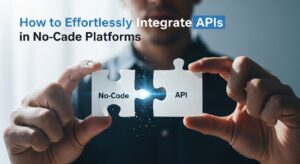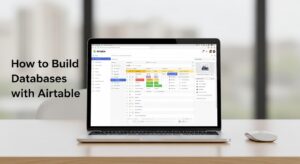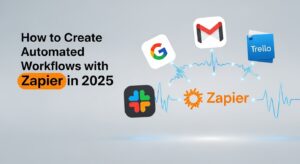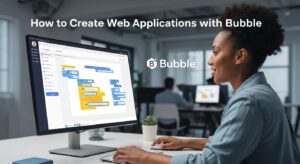The digital era has made one thing clear: you don’t need to be a programmer to create powerful apps and websites. A new wave of tools, known as no-code platforms, has democratized technology, empowering anyone with a great idea to design, launch, and scale digital products without writing a single line of code.
If you’ve ever felt held back by the complexity of programming, this guide is your roadmap. We’ll walk you through how to build apps and websites without coding in 2025, providing a clear, step-by-step strategy for success.
Whether you’re an entrepreneur, a small business owner, a freelancer, or a creative professional, this article will show you how to turn your vision into reality.
Why You Should Learn How to Build Apps and Websites Without Coding
No-code platforms are more than just a passing trend—they are the future of software development. According to Gartner, by 2026, over 80% of all apps will be built using low-code or no-code tools.
Here’s why they’re growing so fast:
- Incredible Speed to Market: You can design and publish a working product in days or weeks, not months. This allows you to test ideas and get user feedback faster than ever before.
- Massive Cost Savings: Hiring developers can be incredibly expensive. No-code solutions dramatically cut costs, allowing you to launch a product with a fraction of the budget.
- Ultimate Accessibility: No-code development puts the power directly into the hands of designers, marketers, and entrepreneurs, allowing them to bring their own ideas to life.
- According to Gartner, by 2026, over 80% of apps will be built using low-code or no-code tools.
What Exactly Are No-Code Platforms?
A no-code platform is a visual development environment that lets you build applications or websites using simple drag-and-drop interfaces, pre-built templates, and visual logic. Instead of typing code, you simply connect visual building blocks and components to create functionality.
Feature | Benefit |
Drag-and-Drop Builder | Visually arrange elements and build user interfaces quickly. |
Pre-Made Templates | Kickstart your project with ready-to-use layouts and designs. |
Workflow Automation | Automate repetitive tasks and connect different apps effortlessly. |
API Integrations | Expand your project’s capabilities by connecting to third-party services. |
Hosting & Deployment | Launch your live app or website with just a single click. |
10 Proven Steps: Build Apps and Websites Without Coding
Follow these steps to go from a simple idea to a launched product.
1. Define Your Goal and Audience
Before you choose a single tool, you need a clear plan. Ask yourself: What problem does my app or website solve? And who is my ideal user?
- Building an e-commerce store? A platform like Shopify is your best bet.
- Need a mobile app? Check out FlutterFlow or Adalo.
- Creating a professional website or blog? WordPress with Elementor or Webflow can deliver stunning results.
2. Choose the Right No-Code Platform
Your choice of platform will determine what you can build. Each tool has unique strengths, from creating complex web applications to building beautiful e-commerce stores.
Pro-Tip: For a detailed breakdown of how to find the perfect tool, read our in-depth guide: How to Choose the Best No-Code Platform: 7 Essential Steps for Success
3. Design the User Experience (UX)
Even without code, your app or website still needs a great user experience. Focus on making it intuitive and easy to use.
- Keep navigation simple and logical.
- Use clear and compelling call-to-action (CTA) buttons.
- Gather feedback from real users as early as possible.
4. Accelerate Development with Templates
Don’t reinvent the wheel. Most platforms offer a library of pre-built templates for specific app types, websites, and workflows. Start with a template, then customize it to match your brand and vision.
5. Add Dynamic Features Visually
Modern no-code platforms allow you to add advanced features easily. You can connect to:
- Databases (like Airtable)
- Forms & Surveys (like Typeform)
- Automation Workflows (like Zapier)
- APIs for external integrations
6. Optimize for Mobile Responsiveness
With over 60% of web traffic coming from mobile devices, your project must look great on any screen. Most no-code website builders and app platforms include responsive design features by default, so your work will automatically adapt to phones and tablets.
7. Integrate Automation for Productivity
Want to save time and automate manual tasks? Use a tool like Zapier to connect your apps and services.
Example: When a user submits a form, automatically add their information to a database and send them a confirmation email. To get started, check out our guide: How to Create Automated Workflows with Zapier in 2025
8. Test Your App or Website Before Launch
Testing is crucial for a smooth launch. Don’t skip this step!
- Run beta testing with a small group of real users.
- Check for broken links, slow loading speeds, and usability issues.
- Ensure forms, integrations, and checkout processes are working correctly.
9. Publish and Deploy Your Project
The best part of no-code is the effortless deployment. With a single click, your project goes live, and most platforms handle the hosting for you.
10. Scale and Iterate
The journey doesn’t end at launch. No-code tools make it easy to continuously improve your product. Add new features, integrate advanced APIs, or even transition to a custom-coded solution down the line if your business demands it.
The Best No-Code Platforms for Building Apps and Websites
Choosing the right platform is key. Each one is a powerful tool with its own unique strengths. For detailed tutorials on the most popular options, click on the links below.
Platform | Best For | Key Features |
WordPress + Elementor | Blogs and standard websites | Drag-and-drop design, SEO-friendly, massive plugin ecosystem. Learn how in our guide: How to Create a Website with WordPress and Elementor |
Webflow | High-converting landing pages | Powerful visual designer, responsive layouts, built-in CMS. Find out how to use it here: How to Design High-Converting Landing Pages with Webflow |
Shopify | E-commerce stores | Storefront templates, payment integrations, inventory management. Build your store with our guide: How to Build E-commerce Stores with Shopify |
Bubble | Complex web applications | Database-driven apps, custom workflows, user authentication. Get started on building web apps with: How to Create Web Applications with Bubble |
FlutterFlow | Native mobile apps | Visual UI builder, Firebase integration, native mobile features. See how to create mobile apps with our guide: How to Build Powerful FlutterFlow Mobile Apps: The Ultimate No-Code Solution 2025 |
Airtable | Databases | Spreadsheet-database hybrid, powerful automation, robust API. Learn how to build databases with: How to Build Databases with Airtable |
Zapier | Automation | Connects over 5,000 apps to create automated workflows. Dive deeper into automation with: How to Create Automated Workflows with Zapier in 2025 |
Typeform | Forms & Surveys | Conversational forms, lead capture, powerful integrations. Create engaging forms with: How to Create Forms and Surveys with Typeform |
Advantages and Challenges of No-Code Development
While no-code is an incredible solution, it’s important to understand both the pros and cons.
Advantages:
- Cost Efficiency: Save thousands of dollars on development fees.
- Speed: Launch your product in weeks, not months.
- Flexibility: Test and validate new ideas quickly without a large investment.
- Scalability: Many platforms are built to grow alongside your business.
Challenges:
- Customization Limits: Some unique features may require custom code.
- Platform Lock-In: It can be difficult to move your project to a different platform later.
- Performance Issues: Very complex or heavy apps may run slower than custom-coded solutions.
Pro-Tip: Start with no-code to prove your idea. Once you have an audience and revenue, you can always explore a hybrid solution or migrate to a custom-coded version.
The Future of No-Code in 2025 and Beyond
The no-code movement is here to stay. As platforms become more powerful and intuitive, expect to see:
- AI-powered builders that can design layouts and generate content automatically.
- Deeper API integrations for even more advanced functionality. To learn more, check out our guide: How to Effortlessly Integrate APIs in No-Code Platforms
- Faster hosting with cloud-native infrastructure for superior performance.
Conclusion
Learning how to build apps and websites without coding is one of the most valuable skills you can acquire today. No-code platforms have democratized technology, giving entrepreneurs, creators, and small businesses the power to bring their ideas to life, without depending on expensive developers or complex programming languages.
If you’ve been waiting for the right time to start building, 2025 is your year. With the tools and steps outlined in this guide, you can start today.











